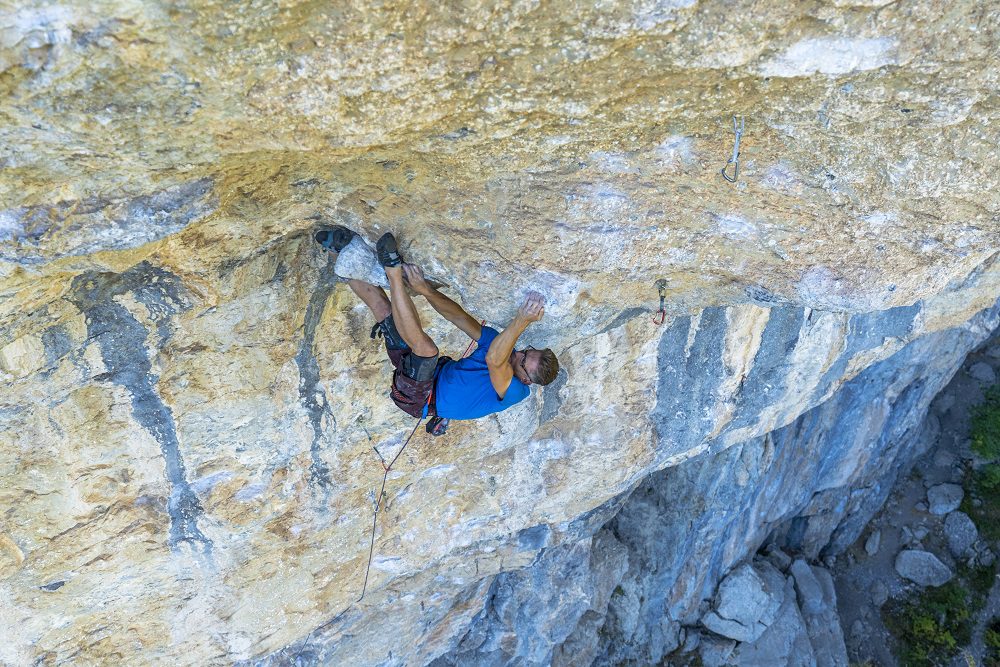Swiss Climber Sends 5.14b at 54
Chris Frick started climbing in 1982, is a guidebook author and has bolted over 400 routes up to 5.14a

Swiss climber and guidebook author Chris Frick just climbed a 5.14b called Stop Sika at 54 years old. The route was bolted in 2002 by Bertrand Martenet and first climbed in 2003 by Didier Berthod. In 2019, Bertrand rebolted the route with a new bouldery direct line, which Samuel Ometz later freed at 5.14b.
“That route has always been my dream,” said Frick. “The line looks so good. Undoubtedly, the technical difficulties and small edges are demanding. To be honest, it was the high grading that scared me. Well, to my generation, 8c [5.14b] still sounds like a trip to Mars. I was 20 years old when this level was considered the highest at the time. I’ve been climbing for four decades now, with the full program of good and bad days, surprises, obstacles and injuries. However, I never stopped, never gave up. Never felt burned out from climbing. For me, climbing is still a source of energy, inspiration and joy. And yet 8c marks a mental barrier. The last route I was able to climb at this level was six years ago. And I was 48 years old then.”
In total, Frick, who started climbing in 1982, has climbed close to 400 routes between 5.13b and 5.14b. He’s also bolted over 400 sport climbs, many of which are between 5.13 to 5.14-, and is the author of the guidebook to the popular Basler Jura in Switzlerland.
As far as Frick knows, there aren’t too many climbers in their mid-50s who’ve sent 5.14b or harder. In 2012, Novato Marín climbed Géminis 5.14a at 61 years old – watch his send here. Earlier this year, we spoke to Ontario climber Garry Reiss who sent his first 5.13 at age 64. During the interview, which you can read here, he had this advice for climbers working on hard routes in their upper years: “Try real hard to stay injury-free. I tore my shoulder kayaking and couldn’t climb for a year which was a real drag, and dynos on that side are still a no no. Every six months, my back goes out and I have to crawl around for a week. You could set an equinoctial marker by it. That started after decking on my one and only ice climbing fall 12 years ago. My eldest daughter is a PT and she shows me all these great exercises that I foolishly do only when I’m hurting. No doubt regular physio would allow me to train and reduce the chance of injury but that would cut into my sitting around time. Bare minimum, I try to eat right, warm up properly and keep climbing, whatever the grade.”
Frick’s first 5.14b was in 2002 with Zeichen der Verwüstung in Basler Jura. He went on to climb other 5.14b routes, such as Enfant de Bohême in Basler Jura, and Goldfinger in Gimmelwald, Switzerland. Some of his hardest first ascents were done in the late 1990s with L’amour directe 5.14a and Apocalipsticks 5.14a – both at Basler Jura.
“I can well imagine that we will see this happening more often in the next 10 or 20 years,” Frick said. “Mainly due to today’s increasing awareness of a good lifestyle and more knowledge about training in old age. I’ve stumbled across many reports of taking T-level supplementals to keep performance high as we age. This should be discussed more widely. I have never taken anything like that, because it is obviously bad, if not dangerous, for the body. There is a natural way to increase T-levels, not just by stopping and sitting down ‘because you’re too old’, but by not stopping moving. That’s what I do. I still have dreams and I won’t stop climbing.”
Over the past few season, Frick attempted other 5.14b routes, such as Mind Control in Oliana, Spain. He works four days a week and gets five vacation weeks a year. “After a very hot summer, temperatures finally dropped in September,” he said. “Maybe too deep, and unexpectedly fast. The send came at the best moment, considering the fact that the route is located in an alpine environment. On Sept. 16, after a perfect go, I was able to clip the chain. I kept my focus, climbed without hesitation or doubts. The next day snow fell all the way down to the base of the crag.
“I’ve had incredible support throughout this entire process, both in terms of encouragement and belays,” Frick said. “Without these I would have got nowhere. Thanks to everyone who helped me along the way.”
Reiss, the Ontario climber who ticked 5.13 at 64, had this advice for climbers looking to send in their upper years: “Try real hard to stay injury-free. I tore my shoulder kayaking and couldn’t climb for a year which was a real drag, and dynos on that side are still a no no. Every six months, my back goes out and I have to crawl around for a week. You could set an equinoctial marker by it. That started after decking on my one and only ice climbing fall 12 years ago. My eldest daughter is a PT and she shows me all these great exercises that I foolishly do only when I’m hurting. No doubt regular physio would allow me to train and reduce the chance of injury but that would cut into my sitting around time. Bare minimum, I try to eat right, warm up properly and keep climbing, whatever the grade.”


